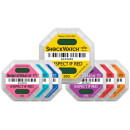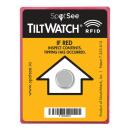The integration of RFID (Radio-Frequency Identification) systems into transport and warehouse management systems offers numerous advantages for companies that want to optimise their logistics processes. In this article, you will learn five tips on how you can use RFID efficiently to improve accuracy, efficiency and security in your supply chain.
Efficient logistics with RFID: 5 tips for optimising transport and warehouse systems!
The integration of RFID (Radio-Frequency Identification) systems into transport and warehouse management systems offers numerous advantages for companies that want to optimize their logistics processes. In this article, you will learn five tips on how to use RFID efficiently to improve accuracy, efficiency and security in your supply chain.
1. Selection of the right RFID System
Choosing the right RFID system is crucial for the success of your logistics optimization. Make sure that the system meets the requirements of your company. The Shockwatch RFID from SpotSee is an excellent example of a reliable system that enables the monitoring and contactless recording of transport goods upon receipt. This system can make a positive contribution to minimizing transport damage. It also offers a user-friendly interface and a high reading range to meet the requirements of different industries.
2. Use RFID Technology for Inventory Optimisation
Efficient warehouse management requires precise inventory information. Use RFID to automatically record and track stock. Continuous monitoring allows you to avoid stock shortages and increase productivity. Modern RFID systems such as the Shockwatch RFID not only enable the recording of inventory data, but also offer functions such as shock monitoring during transportation and storage to prevent transport damage and identify existing problems within the supply chain.
3. Integration of RFID into Supply Chain Management
To take full advantage of RFID, you should integrate it seamlessly into your supply chain management. This way, a lot of information about existing supply chains can be collected and used for optimization, leading to better planning and coordination. For example, many RFID tags can identify shock and vibration events during transportation. This data can then be easily integrated into your existing ERP system by scanning at goods receipt to gain a holistic overview of your supply chains.
4. Training Employees in the use of RFID
The introduction of RFID requires employee training to ensure that the system is used properly. Train your employees on the handling of RFID tags, readers and related processes to minimize human error. A well-trained employee can realize the full potential of RFID and help ensure a smooth implementation.
5. Observe Safety Aspects
Data security is of utmost importance in today's connected world. Make sure your RFID systems meet the necessary security standards to ensure the protection of sensitive information. This includes encryption technologies and access restrictions to prevent unauthorized access to your data.
Conclusion: The targeted use of RFID in transport and warehouse management offers enormous advantages for companies that want to optimize their supply chains. With the right system selection, inventory optimization, integration, training and attention to security aspects, you can make your company more efficient and secure.
Free Counselling Service
Would you like to find out more about how RFID can improve your logistics processes? We offer a free consultation to discuss your individual requirements and propose customized solutions. Book your free consultation now via Calendly!
Our experts are available to answer your questions about RFID and help you make the right decision for your business. Learn how RFID can help you optimize your supply chain and take your warehouse management to the next level. We look forward to accompanying you on your journey to increased efficiency.



